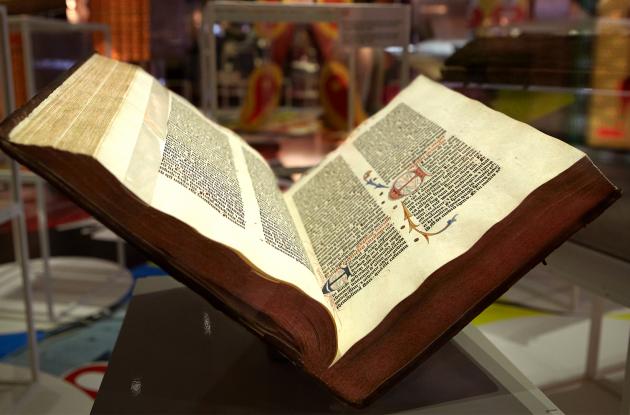The Gutenberg Bible
In the mid-15th century, Gutenberg revolutionised the production of books. He was the first to print books in Europe. Beautifully illuminated ones - and we have one of them.
The German book printer and inventor Johann Gutenberg's Bible from 1454-1455 is the first book printed in movable metal type in Europe. The new technology was the start of a media revolution. Instead of copying books by hand, they could now be mass-produced. Books became significantly cheaper, and knowledge became available to larger and larger sections of the population over time. The foundations for a modern information culture was laid. Although Gutenberg's total of 180 Bibles were mechanically produced, he nevertheless continued a number of traditions from the handwritten Bibles, such as illumination and rubrication.
Before 1454-55, Gutenberg had already published smaller writings, including a text on the World Court (1452-53) and a script directed at the Turks, Eyn manung der cristenheit widder die durken (1454), but in the edition of the Bible from 1454-55, he displayed the strength of the mid-15th century art of printing. The book was presented in the market in Frankfurt, where Aeneas Silvius Piccolomini (later Pope Pius II) saw it and enthusiastically talked of it in a letter dated 12 March 1455.
Gutenberg ended up printing 150 copies on paper and approximately 30 on parchment. Today 49 specimens have been preserved, and we have one of them.
The movable metal type
In the past, printing in both Europe and Asia involved hand carving the text into wooden boards. The revolutionary thing in Gutenberg's invention was the movable type where each letter was cut out separately, so that a new page could be prepared for printing relatively quickly. Movable type had previously been used in China and Korea, but their alphabets consisted of so many characters that 3-4000 different types had to be used for an ordinary book.
The illuminated letters
Gutenberg's printed Bible is the first major book set with movable type and thus the start of a media revolution, but the connection to medieval manuscript production is just as clear as the connection to modern book production. For example, Gutenberg decided that the letter at the beginning of each book (the rubric) should be illuminated separately and by hand. Each rubric had an empty area with only a small letter to indicate which letter the illuminator should draw in a large format. The letter could be festively and colourfully decorated - depending on the client's wallet and taste. Each copy of the printed book was thus individually designed and unique, just like the handwritten Bibles. Only the printed text is the same in all copies.
The many abbreviations
Compared to modern books, the Gutenberg Bible also differs with its many abbreviations, which already existed in the manuscript culture. Many of these Gutenberg transferred to the printed book, but this meant that the typesetter's selection of types had to be so much greater. In the printed Bible, Gutenberg used 299 different types for abbreviations, but the printers reduced the number of abbreviations in later editions.
How did the library get its Bible?
During the 17th century, the dukes at Gottorp Castle near Schleswig built a distinguished library. It was especially famous for its approximately 350 medieval manuscripts, but it also contained more than 10,000 printed books. The entire library became Danish spoils of war in 1713 during the Great Nordic War, and in the middle of the 18th century the collection was incorporated into Royal Danish Library. The library's copy (volume 2) of the famous Gutenberg Bible is one of the items originating from Gottorp. It bears the exlibris of Christian Albrecht (1641-1694), Duke of Schleswig-Holstein-Gottorp, Bishop of Lübeck on the binding.
